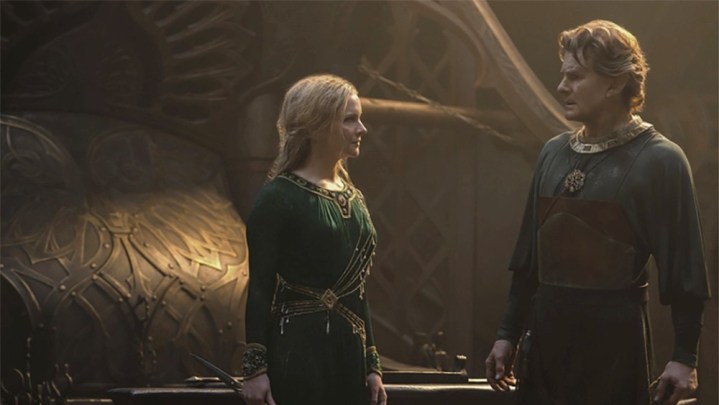Warning: The following article contains spoilers for the season finale of The Lord of the Rings: The Rings of Power.
The mystery at the heart of the first season of The Rings of Power was whether Sauron was somewhere amongst the show’s sprawling ensemble. In the season finale, titled “Alloys,” we get our answer: Halbrand, Galadriel’s human companion and close confidant throughout much of the season, is in fact Sauron. Galadriel discovers that he is not the lost king of the Southlands, and Halbrand a.k.a. Sauron attempts to convince her to join forces with him by showing Galadriel a vision of her long-lost brother. His temptation ultimately fails, and Halbrand leaves Eregion.
Before doing so, though, he helps Celebrimbor unlock the power of the Mithril that Elrond managed to smuggle out of Khazad-dûm in last week’s episode. Galadriel manages to convince both Elrond and Celebrimbor that they should not work with Halbrand, and she tells them to forge three rings instead of one or two. Elrond ultimately discovers that Halbrand is not the king of the Southlands, and their story ends with the forging of the Elven rings of power. The last we see of Halbrand/Sauron, he’s making his way toward Mount Doom.

The episode also features a few moments focused on the Numenorians, including Miriel and Elendir’s return to Numenor and the news that Miriel’s father, the king, has died. Before his death, though, the king confuses Eärien for his own daughter and tells her about the doom that is coming for Numenor if they don’t reforge their alliance with the Elves. He also grants her access to the Palantír so that she can look into the future, although we don’t get to see whatever she sees.
The third major plotline involves The Stranger, who is confronted by the cultists who have been following him. They claim that he is Sauron, but we discover that they are mistaken. He is in fact an Istar or wizard, and may actually be Gandalf, although we don’t yet know that for sure. With some help from Nori and the harfoots, The Stranger determines that he is good and destroys the cultists. Then, he decides that he must set off toward Rhûn, a land in the far east where he can learn more about who he is. Nori decides to strike off with the Stranger, leaving the Harfoots behind.
And that’s where the season finale leaves us. The Elves have their rings of power, Sauron has been revealed, and Nori and The Stranger, who could very well be Gandalf, are off on an adventure. Rings of Power will be back for another season, but until then, we’ll just have to start this season over from the top.
Editors' Recommendations
- Teenage girls acquire the ability to electrocute in The Power trailer
- Best Lord of the Rings characters ever
- Video games to play for fans of House of the Dragon and Lord of the Rings
- Why Lord of the Rings: The Rings of Power can’t be a Game of Thrones rip-off
- The Rings of Power: what you should know about Middle-earth before watching




